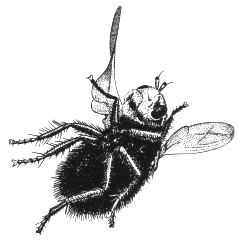 The Evolution of Flight
The Evolution of Flight Of course, every flying insect must be able to produce an airfoil geometry with its wings. Flat wings
simply won't produce any lift. For this purpose, the wings are attached to several muscles similar
to the muscles in our shoulders. These muscles flex various parts of the wings separately, so that the
leading and trailing edges of the wings may be manipulated to create an efficient aerodynamic surface.
Of course, every flying insect must be able to produce an airfoil geometry with its wings. Flat wings
simply won't produce any lift. For this purpose, the wings are attached to several muscles similar
to the muscles in our shoulders. These muscles flex various parts of the wings separately, so that the
leading and trailing edges of the wings may be manipulated to create an efficient aerodynamic surface.
Some species, however, have taken wing torsion to new heights, so to speak. Echinomia grossa
(sketch) can twist the leading edges of its wings through nearly 180 degrees so that the trailing edges
point forwards. In the fantastic stunt manoeuver here depicted,
this fly takes off backwards and sideways. This feat of sheer agility that cannot be matched by any
bird or bat.
If you want to impress your friends at a party, here's how:

 The Evolution of Flight...5, March 1996
The Evolution of Flight...5, March 1996